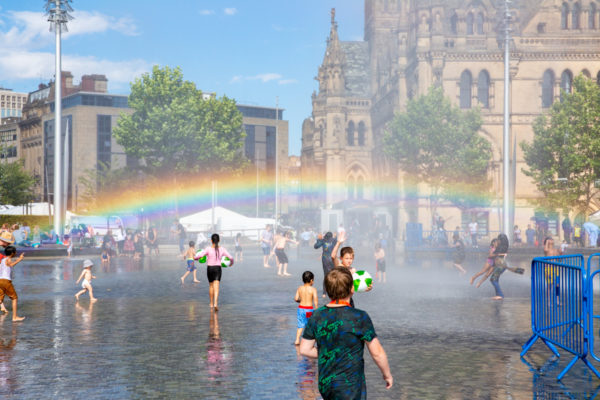Tensions as Strengths: Ways of Working
We have come to see the tensions between being national and being local as a source of strength. We will

A rainbow over Bradford’s City Park. The Tension as Strengths: Ways of Working suggest how the National Science and Media Museum can transform the tensions produced by the museum seeking to work in and with Bradford into creative and fruitful strategies. Image credit: Tim Smith
Here we set out ways of working – developed through workshops with museum staff – that will enable the National Science and Media Museum to turn the tensions into strengths.
Tensions as Strength: Inter/national scope AND local depth
Enter the local through the national and the national through the local
The local and the national are connected ideas. Too often the nation is dislocated and imagined only in abstract or, when it is placed, fixed in capital cities. Yet the nation can be entered from anywhere, and an interesting and engaged approach to what it means to be national is to approach the meanings of England and the UK through Bradford. In the other direction, the National Science and Media Museum’s engagement with Bradford can be approached through the lens of the national and international, linking in people, collections and ideas from other parts of the country and world, and adding the networks of international museums to the trans-local connections that make up Bradford.
What the ‘inter/national scope and local depth’ way of working suggests is the importance of being more specific about which aspect of ‘national’ is being evoked in any instance, and to see the national as always needing a physical and conceptual entry point where ideas and the ground meet. This entry point could be anywhere. The National Science and Media Museum’s entry point to the nation is Bradford, the part of the country on which it is physically built. And the museum’s entry point to Bradford is through this knotty idea of the national which can be usefully broken down to be thought of more concretely as people, funding and collections.
Helen Graham, Project Researcher
See the museum as part of the Bradford ecosystem and the national cultural ecosystem
Be curious about Bradford – and also enable people in Bradford to understand what the museum is
The Science Museum Group is a whole world of people and activity. Bradford is a whole world of people and activity. There is great potential in fully connecting these worlds. This will come through museum staff being deeply interested in Bradford and becoming better at talking openly about the world of the Science Museum Group.
Connect with Bradford’s history to talk internally about whiteness, the legacy of colonialism, racism and anti-racism
Bradford is a place which enables an informed and specific engagement with British history. Bradford is what it is today because of the legacies of the British empire and its connections to, in particular, Pakistan, Bangladesh, India and the Caribbean. Bradford has a long history of anti-racism and inter-faith work that can be drawn on in the National Science and Media Museum’s conversations about race and racism.
Experiment with shifting speed, scale – and prestige
Being responsive and flexible can enable collaborative relationships and there are lots of different ways in which the museum has been experimenting with moving fast. When an exhibition or event is smaller and less resource intensive then the ways of working can be more responsive and flexible and decision-making can be shared with collaborators. The bigger an exhibition or event becomes the more staff from different teams within the museum need to be involved, the more expensive it becomes, the greater the risk and the more it will be expected to attract large audiences. As a result, the process will become slower and the control collaborators have over decision-making will be diluted. Yet with shifts in scale also come shifts in prestige. Prestige is produced through taking up space and attention and therefore prestige (when considered in terms of how the museum currently works) is produced through the very processes that take power away from collaborators. It might be that the trade-offs between greater prestige for loss of power and control are worth it for collaborators – but this needs to be talked about explicitly in future collaborations.
Tension as Strength: Reciprocal relationships AND targeted delivery / Tension as Strength: Quality in outcome AND quality in process
Good processes lead to better outcomes
Co-produce ideas of quality from the beginning of projects.
Too often high-quality outcomes (in terms of exhibitions and events) and high-quality collaborative processes are seen in opposition, but they can be seen as mutually reinforcing. One way of ensuring they are mutually reinforcing is to talk openly about what quality means at the beginning, including making visible all of the issues discussed above produced by increasing scale.
We are not too busy to work well with Bradford – working with Bradford we will save time
Working with Bradford has often been thought of by museum staff as an extra and additional area of work that might get in the way of being able to deliver and, therefore, as an inefficiency. Yet it can be conceived as the opposite. Working well locally will make the museum more efficient by being better informed, being enriched by activity and knowledge in Bradford and, therefore, more able to achieve successful and popular exhibitions and events.
Resource spaces for reflection
Having time to reflect, see the bigger picture and to see your work through other people’s eyes, is key to being able to produce high quality work, on time and on budget.
Tension as Strength: Transparent, safe structures AND creative freedom
People make organisational change. Structures and processes need to be adapted to help culture change happen
Organisations are made up of people. The energy of reflection, discussion and debate can be seen as a means of transforming structures and processes.
Use Science Museum Group decision-making processes to cultivate agency and to support staff to innovate and take risks
It is easy to think of individual agency and organisational decision-making structures as being opposed. But structures can be adapted to enable creative agency and enable innovation.
Tension as Strength: Magic moments AND deep relationships
Recognise the difference between ‘audiences’, in depth outreach work and active connection to Bradford’s civic networks
Build long term relationships with those that are interested… and also recognise there can be magic in a moment
There is a danger in conflating different ways of thinking about people. Audiences visit, take part in an exhibition or event and then leave. Communities are groups you work with in depth, seeking long-term relationships. Being part of a civic network means knowing what is going on and taking part in the discussion about the future of Bradford. Any one person could be at different times an audience member, a community member and a member of the civic network, but the different ways of conceptualising people prompt different ways of working for the museum.
Value Front of House experience as deep knowledge and understanding
The visitor experience team have conversations everyday with people who come into the museum, activating this knowledge is crucial to understanding how the museum can develop.
Tension as Strength: Collecting things AND debating meanings
Activate collections in conversation with Bradford and use Bradford as a lens for the national collection
The collections can be brought to life through conversations with people in Bradford and Bradford – with its position in British history and cultural life – can offer a lens for interpreting the national collection.
Make visible the behind-the-scenes work that enables front of house engagement
To keep collections and people safe in ways which are consistent with policy and law takes a lot of work that is not visible but that nevertheless makes the museum’s exhibitions and events possible. Part of building a better relationship with Bradford is sharing and talking about this behind-the-scenes work and about why it is necessary.
Tension as Strength: Personal relationships AND Strategic Partnerships
Build strategic partnerships through cultivating personal networks
The museum has many strategic partnerships, these can be added to by staff developing their own personal networks which will support future collaborations.
Recognise that there is a history to the museum’s relationship with Bradford – and use this understanding to develop better relationships and partnerships today
The museum has not always been seen as wanting to work with Bradford and that has left a legacy. Knowing this – and, for example, why it is important that not every meeting happens in the museum – will help in building better collaborations in the future.
Tension as Strength: Science knowledge AND everyday experience
See STEM learning as about enabling people to ask questions and question knowledge
See science as social (not its opposite) – and part of everyday life
A new focus on science and technology has been seen as shifting the museum’s mission away from people, but science is social and part of everyday life. Science Capital underpins this as an equity model. Building fluency with science and technology is about encouraging people to ask questions and question knowledge. This makes the museum’s focus on the science and technology of sound and vision a useful focus for connecting people’s experience and the material world through which everyday life is shaped.



